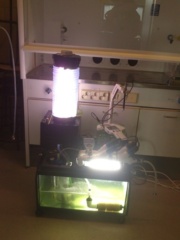Introduction

algae-under-microscope
The increase in the human activity has been degrading the environment rapidly. This project is concerned with the growing water pollution in the Baltic Sea. This research project is being undertaken to develop a bio-refinery concept of Algal cultivation with the help of biomass.
‘
Concept
There are different types of algae. Depending upon the ecosystem and environment they have different outputs. One of the major challenge of this project is to select the best algae required for the project. Chlorella Pyrendoidosa (green algae) is used for this project.
Carbon emission scrubbing using micro algae: Maintaining a carbon neutral cycle. In this project algae will be grown in custom build bio-reactor. CO2 is supplied from a simulated source for laboratory testing. CO2 and nutrients from waste water are the ideal food for algae to become healthy and increase oxygen production. The bio-reactor is sealed and fully automated if there is sufficient solar energy. The pump that moves the algae is operated in 10-20W solar PV. CO2 gas sensor is used to determine the amount of CO2 algae absorb in the process.
On a broader scale, bio-waste and waste water is used to make methane gas and CO2 which in turn can be fed to a CHP, producing hot water, 1kW of power, getting rid of the waste and waste water, meanwhile maintaining the carbon loop. The process would not be visible except for the algae itself, just plug in the cold water inlet and hot water outlet and electricity outlet to the source. All of the technology on a large scale would be housed in a shipping container for easy transport anywhere worldwide. No extra emissions are added. It’s a truly sustainable process.
Note that the emissions from anaerobic digestion produce CH4 and CO2. CO2 travels to algae, CH4 is burned in a CHP which produces more CO2, and then both CO2 streams combined travel to algae cultivation tank.
Since it is tricky to use real emission and real waste water due to various reasons CO2 is going to be made using sugar fermentation. One of the by-product of sugar fermentation by yeast is alcohol. With the DIY CO2, reactor is sealed completely to avoid any alcohol leakage from the container. The alcohol alters the water’s chemistry by changing the pH which, at some point kills the yeast. The more yeast is added, the faster CO2 is produced and so the alcohol. Baking soda is added to buffer the change in pH and make the mixture produce yeast longer. pH will be monitored with a pH meter. Temperature is almost negligible the project is held in the lab in normal temperature and pressure so it can adjusted for algae preference.
The waste-water is simulated by the composition of nutrients found in municipal waste water using liquid fertilizer or something similar. So it could be also adjusted with different strain of algae.
The algae will be grown fish tank of 14L and circulated with 8 mm transparent acrylic pipe around a cylinder tube. Tube is 60cm in height and inside there are 2x 18W lamps with selected wavelengths. There is also a possibility of expanding the tank size and pipe diameter to 10mm. The pump that will circulate the algae will work on a PV panel if there is sufficient solar energy available.
Specific analyses will be carried out for potential bio-fuel production and for the biomass composition to figure out its utilization for heating purpose.




One might invite another student to perform a life cycle assessment on your process, which would be a thesis for them and marketing for you.
I’m impressed. Let’s talk next week about how this is going.Linza@
yes sure. We can discuss in coming friday.
PS- In an industrial application, the algae will pick up mercury and other metals from exhaust, particularly from coal flue gas. Definitely consider an acid wash step at the end of the process to precipitate the metals for recovery, before processing algae for fuel, so that Hg doesn’t keep moving through the cycle with C.
This is very interesting project! Good concept!